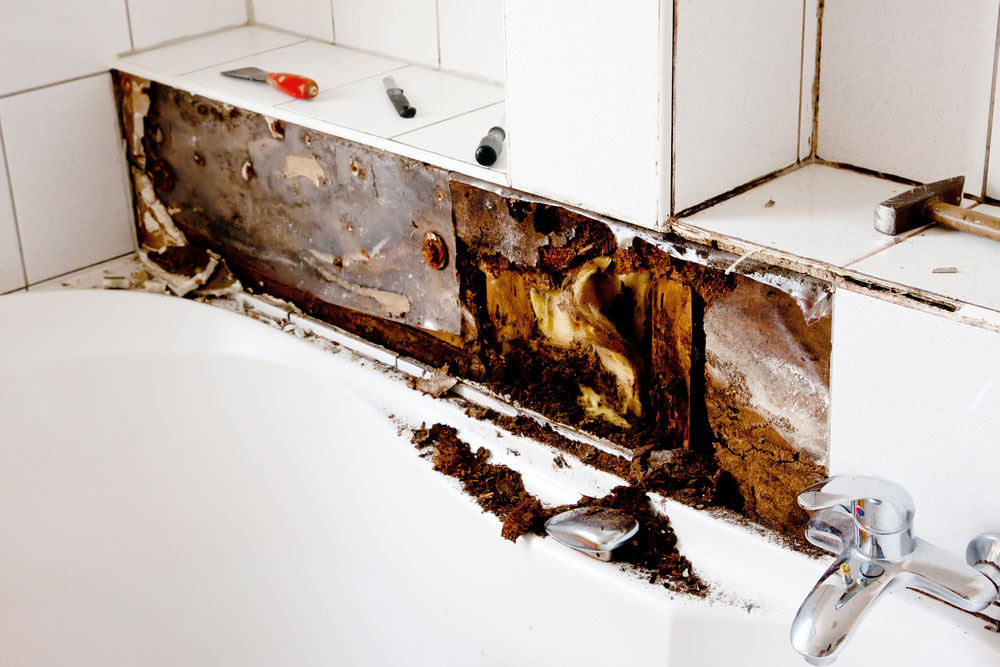Common Root Causes Of Water Damage in a Bathroom
Common Root Causes Of Water Damage in a Bathroom
Blog Article
Are you trying to locate additional info around How to Prevent Bathroom Water Damage?

The shower room is incredibly susceptible for moist accumulation and also possible water damages as a result of the constant use water in it. This post uses easy evaluation methods to help spotting water damage hazards.
The constant use water in the shower room makes it very susceptible for moist buildup and also prospective water damage. By examining it routinely, you can lower water relevant damages.
The following set of examinations is simple to carry out and should be done as soon as in every 3 months in order to keep your bathroom healthy as well as to prevent possible water problems triggered by the bathtub, the shower, pipeline joints and plumbing, sinks, closets, and also the bathroom
Do not neglect executing these assessments and be detailed while doing them. Keep in mind that these straightforward assessments can save you a great deal of money by giving very early indications for water damages
Sinks and Cabinets
Sinks and also cupboards are exposed to dampness as well as moisture everyday and are commonly ignored. Inspect frequently under the sink and on the kitchen counter above it. Fix any type of drip in the catch as it may recommend drain troubles. Browse the sink, slow draining pipelines might indicate an obstructed drainpipe. Replace sink seals if they are split or loose.
Tub and also Shower
The shower and tub call for special interest and also maintenance. Inspect the floor tiles and change if fractured. Ensure that there is no missing cement between the ceramic tiles. Check and also replace split caulking at joints where the wall surfaces meet the floor or the bathtub. Obstructed drains and also pipes troubles will stop the bathtub from drying out and might suggest serious issues beneath the tub. Consult with an expert immediately to avoid architectural damage. Focus on discolorations or soft areas around the bath tub walls as they might show an internal leakage.
Plumbing
Signs for water damages are tough to spot given that most pipelines are mounted inside the walls.
Pay special focus to flooring as well as wall surfaces moisture and spots as they might indicate an undetectable plumbing trouble. Check wetness degrees in adjacent rooms also.
The Commode
The commode is a susceptible water junction. Inspect the water lines and also search for leaks around the bathroom seat, in the hose, as well as under the water storage tank. If you identify any indications of wetness on the flooring around the commode, check for leaks in the toilet rim as well as storage tank seals.
Know that hanging bathroom dish antiperspirants boosts the opportunities for obstructions.
Water Damage Signs In The Bathroom To Avoid Cleanup
Musty smell
This is one of the easiest signs to catch because musty smells are so odorous. The damp, earthy, moldy smell should be a big red flag. The smell will develop when moisture gets trapped in surfaces, and begins to facilitate mold growth. Leaking pipes under cabinets, inside walls, and behind shower fixtures will cause moisture to stay trapped and not dry, which will lead to mold growth and spread. As soon as you notice any musty smells in your bathroom, have it checked for hidden water damage and cleanup signs.
Visible mold
If the smell isn’t there to give it away, sometimes you will actually see mold growth. Finding mold in your bathroom is a serious problem, because mold is very harmful to your health. By the time mold growth is visible, it also means that water damage has already occurred and been present for some time. The only way the mold problem can be resolved is to find the source of the moisture and get it stopped. To safely and adequately remove mold, you need to have professionals handle the remediation. Do not waste any time in getting mold problems addressed, fixed, and sanitized so that you can protect you and your family from the many respiratory symptoms caused by mold exposure.
Damaged floors
Bathroom floors should be able to withstand some exposure to water while still remaining in good condition. However, when excess exposure or water leaks occur, they will begin to damage even the most water-resistant flooring. If you notice any cracking, bubbling, staining, or warping on your bathroom floors, there is probably a water leak somewhere causing the distortion. If you notice areas of the floor have become softer, or even have a spongy feeling, there is probably damage to the subfloor. Subflooring is typically made up of plywood. When plywood is exposed to water or moisture, it will absorb it. Once it has become saturated, the weight of the excess water will cause the wood to swell and soften. Check the floors in your bathroom frequently to catch any of these sings before they lead to damaged subflooring.
Changes on walls
When water leaks behind walls, it will cause changes in the drywall. Peeling plaster, blistering paint, and soggy wallpaper are all good indicators that excess water is building up behind the wall. Water leaking behind drywall will cause it to swell and be soft to the tough. If you start to notice gaps along the trim of your walls, or where tile meets the wall, it could also be a strong indicator that there is a leak behind the wall. Any changes, distortion, or damage on the walls should be evaluated as soon as you notice it to prevent further water damage and cleanup.

I came across that entry about How to Fix a Water Damage Bathroom when doing a lookup on the search engines. Enjoyed reading our review? Please share it. Help other people find it. Thank you for your time. Visit again soon.
Make An Appointment Report this page